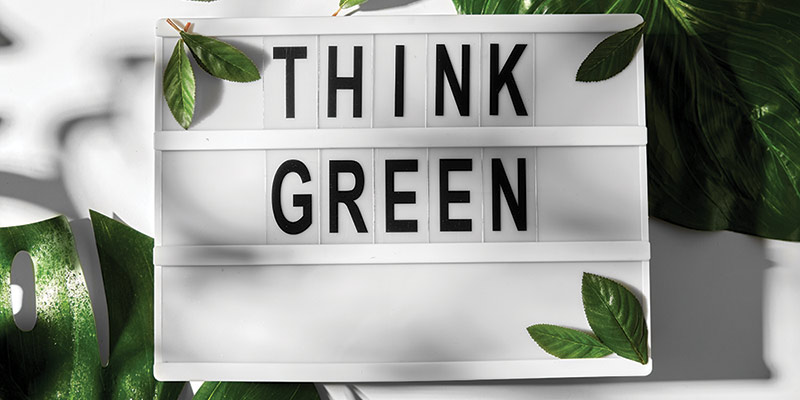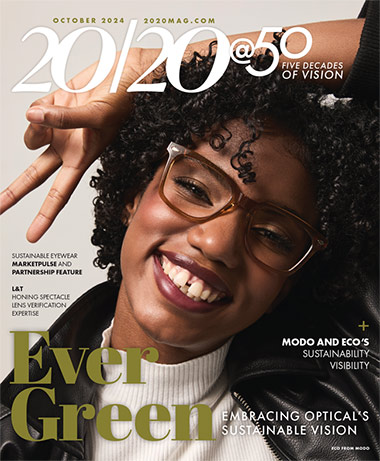
By Linda Conlin, Pro to Pro Managing Editor

Consumers are willing to spend an average of 9.7 percent more on sustainably produced or sourced goods, even with cost-of-living and inflationary concerns, according to PwC’s 2024 Voice of the Consumer Survey press release, published in May 2024. The survey collected the perspectives of more than 20,000 consumers from across 31 countries and territories, and found that 85 percent of consumers are experiencing first hand the disruptive effects of climate change in their daily lives. Consumers are prioritizing consumption that integrates sustainability-focused practices and are assessing sustainability practices including production methods and recycling, eco-friendly packaging and making a positive impact on nature and water conservation.
Tip: Patients want to know where their eyewear came from, and that the manufacturer has sustainable and ethical practices, including for their workers, resulting in brand loyalty. Most know that cheaply made products break more quickly and need to be replaced more often, increasing unsustainability.
Which frame materials are eco-friendly? Titanium is, for one. Titanium is easily recycled, ethically sourced, and durable enough that it doesn’t require as many replacements as cheaper and more. Other materials used for frames are reclaimed wood, bamboo, recycled plastics, biodegradable acetate made of cotton seeds and wood pulp, recycled stainless steel, and reclaimed ocean plastics including fishing nets. One of the most successful plastic alternatives is made out of the oil of castor beans, the seeds of a fast-growing tree in India. Some lenses can be made from castor oil resin, too. Another company has opened a molecular recycling facility that produces cellulosics, sustainable alternative materials for eyewear. Cellulosics are born out of molecular recycling technology that uses hard to recycle plastic waste as a feedstock and breaks it down at the molecular level. Manufacturers are using biodegradable demo lenses, and 3D printing and on-demand production result in little material waste. Packaging, displays and POP also is part of sustainability. Look for brands that substitute biodegradable and recycled materials for plastics in their packaging and display materials.
Patients want to know about energy-efficient production facilities, recycling water and other eco-conscious practices. To promote the need for fewer frame replacements, a sustainable eyewear brand offers a repair service, allowing customers to send in damaged glasses for repairs instead of discarding them. Many sustainable eyewear brands engage in environmental initiatives, such as tree planting, plastic waste cleanup or wildlife conservation efforts, with a portion of their profits dedicated to these causes.
Let your patients know about eyewear brands that have sustainability certifications. ISO 14001 is a standard for adopting environmental management systems, used by businesses seeking to reduce their environmental footprint. Climate Neutral Certification supports businesses in decarbonizing their operations. B Corp Certification is an assessment that measures a business’ overall responsible sourcing for eyewear specifically made from wood. The Global Recycle Standard (GRS) certification is significant for eyewear produced from recycled materials. It guarantees that the products meet stringent criteria for recycled content and responsible production processes. These certifications empower patient choices and support brands that align with their values of sustainability and environmental stewardship.
Tip: Get the sustainability message to your patients at point of sale. Be sure that staff understand the brand story behind the sustainable products you offer. That includes materials, manufacturing processes, packaging and what the manufacturer is doing to reduce their environmental impact on the community, as well as certifications the manufacturer has earned.
What about contact lenses? One manufacturer already produces lenses with 100 percent renewable energy including wind and solar, and now places packing slips inside sustainable shipping boxes, eliminating plastic outside pouches. Manufacturers are collecting and recycling contact lenses, blister packs and foils through collaboration with TerraCycle, a world leader in the collection and repurposing of hard-to-recycle post-consumer waste. Another manufacturer has achieved GreenCircle Zero Waste to Landfill Certification by diverting 100 percent of total waste from landfills. And another company pioneered the first net plastic neutral contact lenses by funding Plastic Bank’s collection, processing and reuse of general ocean bound plastic waste equal to the weight of the plastic contained in orders of designated products in North America and Europe.
Tip: Learn how the contact lens brands you offer are eco-friendly. Let patients know they can have a healthy lens-wearing experience while helping the planet.
Patients want to know what your practice is doing to be environmentally friendly. Start with waste from the office. It can be easy to incorporate recycling and composting into your practice with many commercial waste companies offering those services and receptacles. Donate glasses to the needy and have staff volunteer for environmental causes in the community. That can garner media attention to let patients know you take sustainability seriously. Be sure to include those activities on your website and social media.












